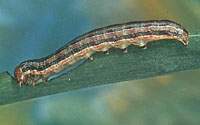Armyworms Moving Across the State
Armyworms Moving Across the State

Armyworms have been eating their way through small grains, pastures and hayfields in west Kentucky for several weeks and are now being spotted in fields in central Kentucky.
Consequently, the U.S. Environmental Protection Agency has granted special registration to two insecticides to combat armyworms in pastures and hayfields in Kentucky, the state department of agriculture has announced.
The insecticides are Pounce 3.2 EC and Confirm 2F. Both are restricted use pesticides. If necessary, cattle can be present during application when Pounce is applied and producers may also let their animals graze fields after treatment.
However, pastures sprayed with Pounce cannot be cut for hay during the remainder of the season. Pastures sprayed with Confirm can be harvested for hay after a 14-day wait.
Applicators must have a copy of the appropriate state (C-24) label for Pounce or the crisis exemption label for Confirm. These are available from the pesticide dealer when the products are purchased.
The first generation of armyworms is over in west Kentucky but the adult stage moth is being caught in traps at the University of Kentucky Research and Education Center in Princeton, according to Doug Johnson, UK Extension entomologist and state Integrated Pest Management coordinator.
"It's too early to tell how destructive the second generation will be," Johnson said. "But it will be very important to check pastures if flights are as heavy as the early one this spring that triggered the outbreak."
Last week a sample from a Henry County pasture contained worms that were about a half to two thirds grown, said Lee Townsend, UK Extension entomologist.
Because of that sample, Townsend sent out information to Extension agriculture agents last week alerting them that while the infestations in western Kentucky should have subsided it is possible armyworms are still active in central and eastern parts of the state.
"It's a reminder to farmers in that area to check their pastures for armyworm activities," he said.
More recently, damage has been reported in no-till corn planted into grass or small grain cover crops in Clark, Bourbon and Wayne counties.
Armyworms are probably in pastures every year in very low numbers, Townsend said. But it is unusual for them to be there in the numbers seen this season. Typically if it is not time to cut hay, fields don't get checked regularly and armyworm activity can show up and cause damage in a very short period of time.
The insects do about 90 percent of their feeding in the final stage of their life cycle. Damage seems to appear overnight when, in fact, the insects have been around for some time. The worms can reach about 2 inches in length at maturity.
Since large numbers of armyworms have not only been seen in Kentucky, but throughout this region of the United States, Townsend said farmers should be scouting for the armyworms.
There are two armyworms that show up in Kentucky. One type referred to as the "true armyworm" is the one being seen in area pastures. This worm is here every year and normally appears in April, May and June, Townsend said. It has several generations and overwinters here.
Fall armyworms, which are a migratory insect that comes in from the south, appear later on in the state. They generally attack late-planted crops, especially corn.
"Typically, we don't see the true armyworm at damaging levels in pastures and that's what has been unusual this year," Townsend said.
In addition to hay and pasture fields, the worms have been found in wheat fields in western Kentucky.
"They've been very heavy in wheat but wheat tends to be watched carefully and scouted for insects, weeds and diseases," he said. "So I think the infestations got picked up there in a timely manner. Where we got caught was in pastures where they aren't watched as carefully."
The worms can also damage young corn. If they are feeding in a pasture nearby and run out of feed they will move, en masse, to another area to find another feed source. So it is particularly important to watch for them in row crops, he said.
Townsend said it may be easier to find signs of their presence rather than actual worms. During sunny days they tend to be hidden. If worms aren't seen, look for damage to edges of leaves and for droppings on the ground. Look in soil cracks or under surface residue to actually find the worms.
Controlling the worms is relatively easy in row crops, with many products available for use.
Pastures should recover as the worms move away in search of more leaf tissue. Recovery should be good where there is rainfall to spur regrowth, but it will be poor where conditions are dry and the sun is beating down on the exposed crown of the grasses. In those cases, you can get some plant loss.
